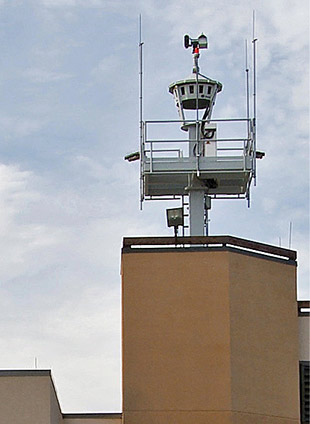High hopes for new ATC technology
A stunning array of 14 high-definition monitors provides a glimpse into what could be the future of air traffic control. SAAB Technologies has finished the initial stage of testing on the nation’s first remote air traffic control tower. Remote towers are much cheaper to build and maintain than traditional towers. The remote tower works using cameras mounted on top of the terminal. This gives controllers a clear, 360-degree view of the field. Controllers can work either at the airport or from a remote location. The first tower is being tested at Leesburg Executive Airport in Virginia.
 “We’ve been observing traffic at Leesburg since August, and our objective is to assemble observations to go to the FAA safety panel and present a case that says this technology is as safe and as reliable and as efficient as a brick-and-mortar tower,” said Matt Massiano, director of business development for SAAB.
“We’ve been observing traffic at Leesburg since August, and our objective is to assemble observations to go to the FAA safety panel and present a case that says this technology is as safe and as reliable and as efficient as a brick-and-mortar tower,” said Matt Massiano, director of business development for SAAB.
Looking at the monitors, controllers have many of the same tools they have in a traditional tower. They can use a pan-tilt zoom camera to look for traffic as they would in person. They can even shoot light gun signals. It is all controlled using a touchscreen.
Controllers also can use technology not available in a traditional tower. “We can overlay radar data when available, [and] provide a data block on the picture so a controller could see arriving traffic that might be 10 miles away,” said Massiano.
SAAB has high hopes for the technology. After approval from the FAA the company plans to use the remote tower to make Leesburg a Class D airport.
“I think the pilot community will be very happy with the results they see here. I know I am looking forward to it,” said Massiano. “I think it’s going to smooth operations out a lot and I think we will see a real improvement in the way things work.”
There are many options for what the technology could be used for in the future. “I think we can provide services to airports that don’t have air traffic control services. We could provide service from a tracon where we could see a runway where we are shooting an ILS approach, we could see that airplane land and turn off, and shoot the next ILS approach. Really to us it fits right into NextGen, enhancing the safety and making it more efficient,” he said.
 The technology opens a lot of opportunities to smaller airports such as Leesburg.
The technology opens a lot of opportunities to smaller airports such as Leesburg.
“We expect to see more business aircraft coming in here that are going to Dulles [International Airport] now. We think this is a good business tool allowing better utilization of this airport, better utilization of the national airspace, and better use of the business travelers’ time,” said Massiano.

